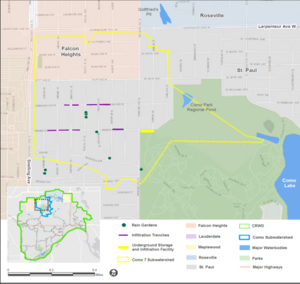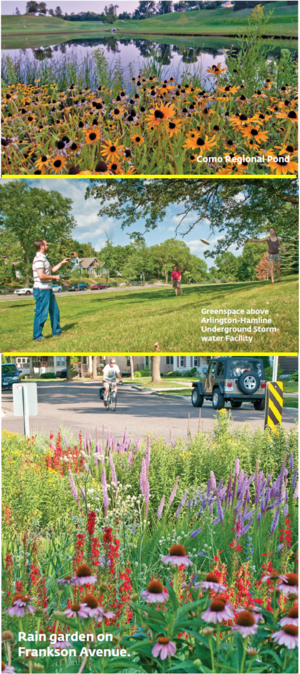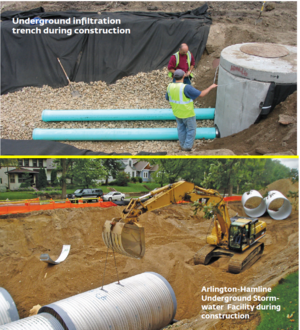
Difference between revisions of "Arlington-Pascal Project"
m |
m |
||
| Line 81: | Line 81: | ||
*TSS reduction costs: $0.34 - $1.07 per pound of TSS removed | *TSS reduction costs: $0.34 - $1.07 per pound of TSS removed | ||
*TP reduction costs: $395 - $1,100 per pound of TP removed | *TP reduction costs: $395 - $1,100 per pound of TP removed | ||
| + | <font size=1><sup>2</sup>Pollutant cost-benefit analysis and removal estimates were based on data and modeling conducted in 2007-2010</font size> | ||
'''Documented Maintenance Practices''': | '''Documented Maintenance Practices''': | ||
| Line 98: | Line 99: | ||
'''Noteable Challenges''': The large-scale GI implementation was one of the first of its kind in the Twin Cities Metropolitan Area, and required careful planning and collaboration with many stakeholders.<br> | '''Noteable Challenges''': The large-scale GI implementation was one of the first of its kind in the Twin Cities Metropolitan Area, and required careful planning and collaboration with many stakeholders.<br> | ||
'''Other Benefits''': The numerous trees on site improve air quality, and reduce air temperature and urban heat island effect. The raingardens provide pollinator habitat and traffic calming. | '''Other Benefits''': The numerous trees on site improve air quality, and reduce air temperature and urban heat island effect. The raingardens provide pollinator habitat and traffic calming. | ||
| − | |||
| − | |||
'''References and External Links''': | '''References and External Links''': | ||
Revision as of 14:07, 24 February 2021

Prior to the implementation of the Arlington-Pascal Project, an area west of Como Lake known as the Como 7 subwatershed (see right photo), experienced frequent flooding and contributed to the pollution of Como Lake. Como Lake was listed as an impaired water by the Minnesota Pollution Control Agency (MPCA) in the 2002 303(d) list. The impaired use is aquatic recreation, with the stressor identified as “nutrient/ eutrophication biological indicators."
Rather than build costly gray infrastructure to alleviate the flooding and reduce pollution, Capitol Region Watershed District (CRWD), the cities of Saint Paul, Falcon Heights, and Roseville, and Ramsey County worked together to construct eighteen stormwater features as part of planned street reconstruction. These stormwater best management practices (BMPs) include rain gardens (bioretention practice), infiltration trenches, an underground stormwater storage and infiltration facility (the Arlington-Hamline Underground Stormwater Facility), and improvements to Como Park Regional Pond. The infiltration trenches and the Arlington-Hamline facility include pretreatment to optimize their performance. Collectively, these features reduce stormwater by capturing and slowing down the stormwater to prevent flooding, filter the stormwater to prevent pollution, and beautify the neighborhood with green infrastructure. The Arlington-Pascal Project was the first large-scale capital improvement project ($2.7 million) implemented by CRWD, including design, construction and bond interest costs for the project. Construction of the project BMPs began in 2005 and was completed in 2007.
CRWD staff complete monthly inspections of the rain gardens and contracted maintenance crews perform routine maintenance on a monthly schedule. Inspection items and tasks are listed in the table below.
| Routine Inspection or Maintenance Tasks 1 | |||
| BMP and surrounding area free of trash and debris | BMP clear of dead plant material (including leaves) | ||
| BMP is free of accumulated sediment (if not, take measurement) | Quantity of sediment and organics removed (gallons) | ||
| Inlet(s) and pretreatment clean | Quantity of trash removed (gallons) | ||
| Outlet clear of trash and debris | BMP free of graffiti or other vandalism | ||
| BMP is weed free | |||
| Additional Inspection or Maintenance Tasks 1 | |||
| BMP is free of standing water (24 hours after rainfall) | Soil is stable and free of erosion | ||
| Mulch is evenly distributed and 2"-3" deep | Site is fully vegetated with healthy plants | ||
| 1 In the winter, inspections and maintenance are only done on an as-needed basis. | |||
Staff and crew use a mobile application to fill out an inspection form, record relevant information, and take photos. These data are automatically updated to a database where CRWD can evaluate them and the program, and keep track of maintenance expenses.
Extensive monitoring and modeling efforts have been conducted by CRWD since the project BMPs became operational. These efforts calculate and track the operation and performance of the individual BMPs and the project as a whole. Specifically, monitoring and modeling activities have aimed to determine BMP performance with regards to volume reduction, total phosphorus (TP) load removal, and total suspended solids (TSS) load removal. The inlets and outlets of the Arlington-Hamline Facility, Como Park Regional Pond, and two out of the eight infiltration trenches are monitored for water quality and/or flow while the rain gardens are monitored for peak water levels only.
Year of completion: 2007
Location: Como 7 subwatershed, West of Como Lake, Saint Paul MN
Owner: Capitol Region Watershed District, in partnership with the City of Saint Paul MN
Designer: Emmons and Olivier Resources
Building Type: Public
Design Features:
- One large underground stormwater storage and infiltration facility (the Arlington-Hamline Underground Stormwater Facility)
- One regional stormwater pond (Como Park Regional Pond)
- Eight rain gardens
- Eight underground infiltration trenches
- General storm drain improvements
Pretreatment Features:
- Arlington-Hamline Facility: Contech Vortech® Model 7000 hydrodynamic separator
- Infiltration trenches: sumped manholes and sumped catchbasins
Total Drainage Area:
- Arlington-Hamline Facility: 50 acres
- Como Park Regional Pond: 128 acres of direct drainage and 522 acres of indirect/managed drainage, for a total of 650 acres
- Infiltration trenches: 23 acres
- Rain gardens [bioretention]: 16 acres
Total Construction Cost: $2.7 million, including design, construction and bond interest costs for the project
- Arlington-Hamline Facility: capital cost = $800K; annual O&M cost = $3.1K
- Como Park Regional Pond: capital cost = $1.3M; annual O&M cost = $6.5K
- Infiltration trenches: capital cost = $400K; annual O&M cost = $7.1K
- Normalized Construction Costs: $14,300 per watershed acre; $32,600 per impervious acre
- Normalized 35 year Projected O&M Costs: $5,400 per watershed area; $12,300 per impervious area
Pollutant Cost-Benefit Analysis2:
- Volume reduction costs: $0.03-0.06 per cubic foot of stormwater removed
- TSS reduction costs: $0.34 - $1.07 per pound of TSS removed
- TP reduction costs: $395 - $1,100 per pound of TP removed
2Pollutant cost-benefit analysis and removal estimates were based on data and modeling conducted in 2007-2010
Documented Maintenance Practices:
- Arlington-Hamline Facility: routine inspections and trash removal from the pond’s perimeter, inlet, and outlet
- Como Park Regional Pond: routine inspections and trash removal from the pond’s perimeter, inlet, and outlet
- Infiltration trenches: routine inspections and debris and sediment removal from the pretreatment units, as well as manhole gasket replacement as needed
- Rain Gardens: routine monthly inspections and mowing, debris and trash removal, weeding, leaf removal, and thinning of plants
Pollutant Removal Estimates2:
- 155 pounds of phosphorus and 38,300 pounds of total suspended solids per year from the water quality practices
- 35 pounds of phosphorus and 32,000 pounds of particulate pollution per year from the Arlington-Hamline Underground Stormwater Storage Facility
- 90 pounds of phosphorus and 156,000 pounds of solid and particulate pollution per year from the Como Park Regional Pond
- 20% reduction annually in stormwater volume (1.9 million cubic feet) from the stormwater practices
Access: Publicly accessible
Special Design Features: At the time this project was conceived, these were some of the earliest large-scale green infrastructure practices installed in the Twin Cities Metropolitan Area that used a treatment train approach.
Noteable Challenges: The large-scale GI implementation was one of the first of its kind in the Twin Cities Metropolitan Area, and required careful planning and collaboration with many stakeholders.
Other Benefits: The numerous trees on site improve air quality, and reduce air temperature and urban heat island effect. The raingardens provide pollinator habitat and traffic calming.
References and External Links:


